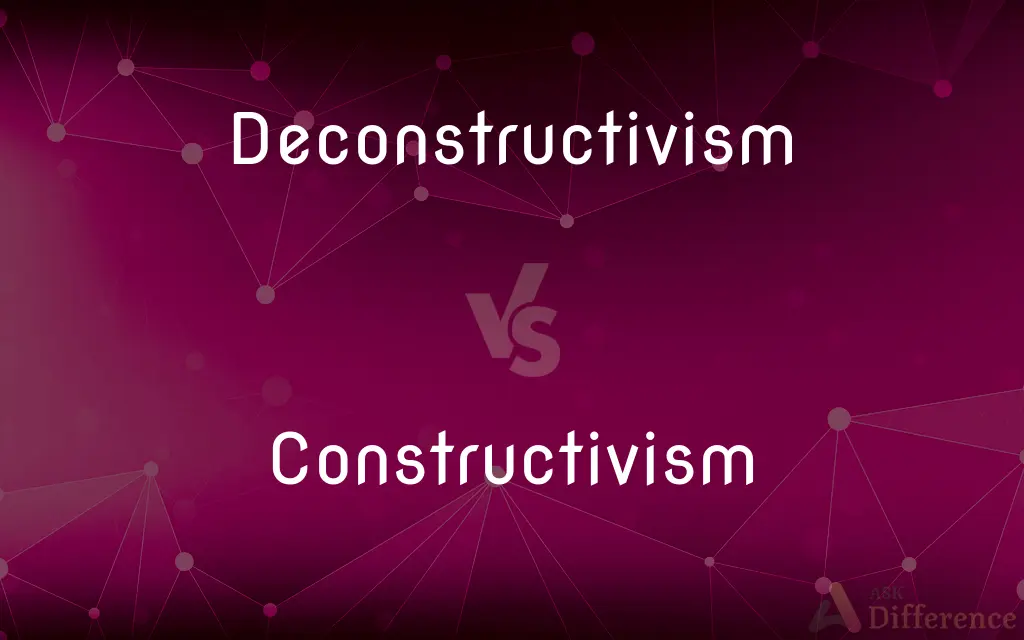Deconstructivism vs. Constructivism — What's the Difference?
By Fiza Rafique & Maham Liaqat — Updated on April 26, 2024
Deconstructivism challenges traditional architectural forms through fragmentation, while Constructivism focuses on functionality and societal needs.

Difference Between Deconstructivism and Constructivism
Table of Contents
ADVERTISEMENT
Key Differences
Deconstructivism is known for its radical appearance, featuring irregular shapes and non-linear design elements. On the other hand, Constructivism emphasizes practicality and often incorporates a linear and geometric aesthetic.
In Deconstructivism, there is an intentional departure from harmony and typical structure, aiming to disrupt the conventional visual expectations. Whereas, Constructivism seeks to embody ideals of efficiency, purpose, and industrial influences in design.
The philosophy behind Deconstructivism often relates to postmodernist skepticism and a critique of established norms. In contrast, Constructivist architecture was born out of a revolutionary spirit in early 20th-century Russia, promoting ideals that served the community and utilitarianism.
Deconstructivist architects like Frank Gehry and Zaha Hadid focus on form over function, creating buildings that can appear chaotic and fragmented. Conversely, Constructivist architects, such as Vladimir Tatlin, designed structures that highlighted material and technological advancements useful to society.
Materials in Deconstructivism are used expressively to enhance the unpredictability and dynamic forms. Conversely, in Constructivism, materials such as glass, steel, and concrete are chosen for their practical qualities and industrial connotations.
ADVERTISEMENT
Comparison Chart
Philosophy
Postmodern critique of established norms
Functional and societal benefit
Aesthetic
Fragmented, irregular, non-linear
Linear, geometric, orderly
Form vs. Function
Form over function
Function over form
Key Architects
Frank Gehry, Zaha Hadid
Vladimir Tatlin, El Lissitzky
Materials
Used expressively for dynamic forms
Chosen for practicality and industrial use
Compare with Definitions
Deconstructivism
Deconstructivism is an architectural style marked by fragmentation and non-linear processes.
The Guggenheim Museum in Bilbao exemplifies Deconstructivism with its contorted metallic forms.
Constructivism
Constructivism is a form of architecture that combines technological innovation with artistic expression.
The Tatlin's Tower was a monument to modern industry and utilitarian art.
Deconstructivism
It seeks to dislocate traditional architectural elements.
Deconstructivist buildings often feature slanted walls and ceilings.
Constructivism
Constructivism is closely tied to ideas of social functionality and communal benefits.
Constructivist projects like worker's clubs were designed to be both practical and culturally uplifting.
Deconstructivism
The style is often associated with an unpredictable and dynamic aesthetic.
The Vitra Design Museum shows how Deconstructivism can manipulate conventional building shapes.
Constructivism
Materials are selected for their practical qualities and efficiency.
Glass is often used in Constructivist architecture for its practicality and ability to create transparent facades.
Deconstructivism
Deconstructivism emerged in the late 20th century as a radical departure from modernist symmetry.
Frank Gehry's work often includes disjointed panels and surprising twists.
Constructivism
It prioritizes functionality and aims to reflect modern industrial society.
Constructivist buildings often use materials like concrete and steel for their structural simplicity and strength.
Deconstructivism
It often incorporates a variety of materials to enhance visual disarray.
The Seattle Central Library uses glass and steel to create a sense of open, fragmented space.
Constructivism
Originating in early 20th-century Russia, it emphasized construction over decoration.
El Lissitzky's designs are focused on functionality with minimal ornamental elements.
Deconstructivism
Deconstructivism is a movement of postmodern architecture which appeared in the 1980s. It gives the impression of the fragmentation of the constructed building, commonly characterised by an absence of obvious harmony, continuity, or symmetry.
Constructivism
A style or movement in which assorted mechanical objects are combined into abstract mobile structural forms. The movement originated in Russia in the 1920s and has influenced many aspects of modern architecture and design.
Deconstructivism
An architectural style developed in the 1980s, characterized by unconventional, often arresting design elements, such as curved or sloping walls, slanted columns, and asymmetric structures and spaces.
Constructivism
A view which admits as valid only constructive proofs and entities demonstrable by them, implying that the latter have no independent existence.
Deconstructivism
(architecture) A development of postmodern architecture that began in the late 1980s, characterized by ideas of fragmentation, an interest in manipulating ideas of a structure's surface or skin, and non-rectilinear shapes which serve to distort and dislocate.
Constructivism
A movement in modern art originating in Moscow in 1920 and characterized by the use of industrial materials such as glass, sheet metal, and plastic to create nonrepresentational, often geometric objects.
Deconstructivism
A school of architecture based on the philosophical theory of deconstruction
Constructivism
(arts) A Russian movement in modern art characterized by the creation of nonrepresentational geometric objects using industrial materials.
Constructivism
(mathematics) A philosophy that asserts the need to construct a mathematical object to prove it exists.
Constructivism
A psychological epistemology which argues that humans generate knowledge and meaning from their experiences.
Constructivism
An abstractionist artistic movement in Russia after World War I; industrial materials were used to construct nonrepresentational objects
Common Curiosities
What was the cultural impact of Constructivism in the 20th century?
Constructivism had a profound impact on design and architecture, particularly in the Soviet Union, where it was aligned with the ideals of the new socialist society and its emphasis on functionality and communal benefit.
How do Deconstructivist buildings typically differ in appearance from Constructivist buildings?
Deconstructivist buildings often appear fragmented and chaotic, while Constructivist buildings are more orderly and geometric.
What is Deconstructivism in architecture?
Deconstructivism is an architectural movement characterized by fragmentation and non-traditional building forms that challenge conventional aesthetics and structures.
Why did Constructivism focus on societal needs in architecture?
Constructivism arose in post-revolutionary Russia, a time of social reform and industrial advancement. Architects adopted this style to reflect and promote the societal ideals of functionality, accessibility, and communal benefit, aiming to support the development of a new socialist society.
Can Deconstructivism be seen as functional?
While Deconstructivism prioritizes form and aesthetic innovation, it can incorporate functional elements, though they are not the primary focus.
What impact did Constructivism have on international architectural styles?
Constructivism significantly influenced modern architecture worldwide, particularly through its emphasis on minimalism, the use of industrial materials, and the integration of technology into design. These principles helped pave the way for later movements like modernism and high-tech architecture, which similarly value technology, functionality, and clear structural expression.
How do the philosophies of Deconstructivism and Constructivism influence their architectural designs?
Deconstructivism's philosophy challenges traditional architectural norms and explores fragmentation and non-linear designs, creating visually striking and unpredictable structures. Constructivism, on the other hand, is rooted in the ideology of utility and social purpose, leading to designs that emphasize practicality and efficient use of materials.
What defines Constructivism in architecture?
Constructivism is an architectural philosophy that emerged in Russia after the revolution, emphasizing materiality, simplicity, and a functionality that serves societal needs.
Can Deconstructivist and Constructivist elements be combined in a single project?
While theoretically possible, combining Deconstructivist and Constructivist elements in a single project is rare due to their contrasting philosophies; Deconstructivism focuses on form and aesthetic disruption, whereas Constructivism is about functional design and social utility. However, a skilled architect might blend these elements creatively to produce a unique structure.
What materials are commonly used in Deconstructivist architecture?
Deconstructivist architecture frequently uses materials such as titanium, glass, and unconventional forms of concrete and steel, which help achieve the signature fragmented and dynamic aesthetics of the style.
Share Your Discovery

Previous Comparison
Scouse vs. Liverpudlian
Next Comparison
Lac vs. LasAuthor Spotlight
Written by
Fiza RafiqueFiza Rafique is a skilled content writer at AskDifference.com, where she meticulously refines and enhances written pieces. Drawing from her vast editorial expertise, Fiza ensures clarity, accuracy, and precision in every article. Passionate about language, she continually seeks to elevate the quality of content for readers worldwide.
Co-written by
Maham Liaqat













































